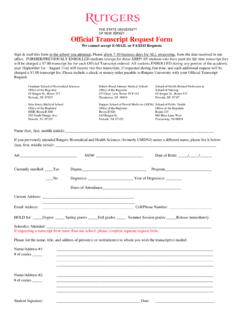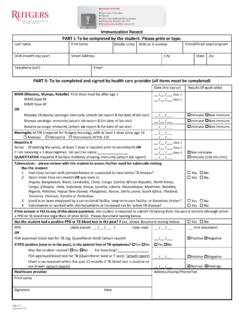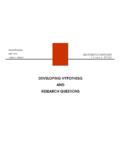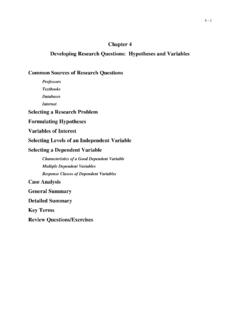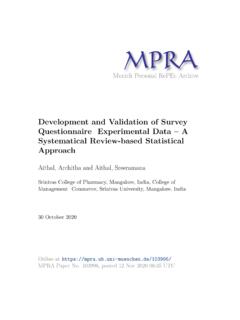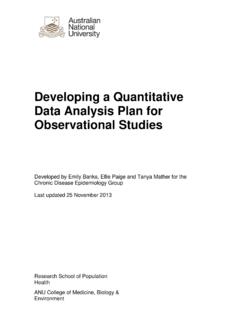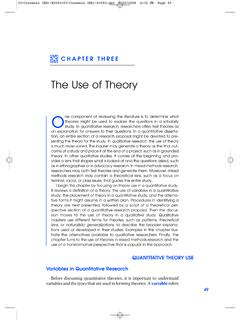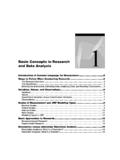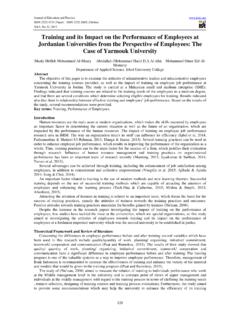Transcription of DEFINITION OF A RESEARCH PROJECT AND …
1 DEFINITION OF A RESEARCH PROJECT AND SPECIFICATIONS FOR. FULFILLING THE REQUIREMENT. All Internal Medicine residents are required to complete a RESEARCH PROJECT during their residency. A RESEARCH PROJECT is a scientific endeavor to answer a RESEARCH question. RESEARCH projects may include: Case series Case control study Cohort study Randomized, controlled trial Survey Secondary data analysis such as decision analysis, cost effectiveness analysis or meta-analysis. Each resident must work under the guidance of a faculty mentor. Depending on your area of RESEARCH interest or your RESEARCH topic, you may be able to identify a mentor on your own, or if needed, you will be assigned one.
2 You are also provided with a step-by-step guide to simplify the process and a suggested Timeline for RESEARCH PROJECT completion to ensure that you meet your requirement in a timely manner. A GUIDE TO THE RESEARCH PROCESS. I. SELECTION OF THE RESEARCH TOPIC: The first major challenge in conducting RESEARCH The easiest way is working with a faculty mentor who is active in RESEARCH and may have defined one or more researchable questions. Consulting with leading faculty in your area of interest and asking for advice on researchable topics is another avenue for RESEARCH ideas. Developing RESEARCH ideas from loose ends discovered during: a) patient care, b).
3 Reading within an area, c) reviewing journal article(s), and d) discussions, critique of RESEARCH articles in journal club, could be an interesting, and a rewarding experience. II. DEVELOPING THE RESEARCH PROPOSAL. A RESEARCH proposal helps you to develop your RESEARCH idea into a valid, scientific RESEARCH PROJECT . A general outline of the elements of a RESEARCH Proposal is presented. Although the RESEARCH PROJECT Outline provides a description of all the elements of a RESEARCH PROJECT , you are required to complete the writing up of the Methodology section BEFORE you begin PROJECT implementation. Writing of the RESEARCH proposal has a twofold purpose: 1) it provides you, the researcher, with the blueprint for implementing your PROJECT , and 2) it has to be submitted to the IRB Committee for securing IRB.
4 Approval to implement your PROJECT . Besides, it is easier to write up the Results and Discussion sections once you have the preliminary sections in place. III. SECURING IRB APPROVAL. IRB approval has to be secured BEFORE you begin collecting your data. In order to do so, you need to send copies of your proposal, and patient Consent Form (for prospective, clinical trials) to the IRB ( ). The Vice Chair of RESEARCH (Dr. Nancy Connell) will review your IRB proposal prior to submission to double-check format and value. IV. PROJECT IMPLMENTATION. In order to conduct a valid, scientific study, it is important that you rigorously follow the study design outlined in your RESEARCH proposal and approved by the RESEARCH Committee.
5 Also, to ensure timely completion of your PROJECT , it is important that you stay within the framework discussed in the Timeline. A one to 3-month RESEARCH elective could be taken to provide you with the needed time. V. WRITE-UP OF PROJECT RESULTS AND DISCUSSION. This should follow directly from your RESEARCH proposal. The RESEARCH PROJECT outline provides a how to' write-up of the results and discussion sections. VI. RESEARCH PRESENTATION. Once your RESEARCH PROJECT is complete, you have to make a public oral presentation to present your work. A formal RESEARCH Presentation provides you with the opportunity to share your RESEARCH with your colleagues, and the department faculty, and provides you with the confidence required to give presentations at regional and national conferences.
6 OUTLINE OF A RESEARCH PROJECT . I. TITLE PAGE (Page 1, DO NOT NUMBER). Study Title Names of principal investigator(s) and co-investigator(s). Division Department of Medicine UMDNJ-New Jersey Medical School, Newark, New Jersey Date: month and year proposal prepared/submitted II. SUMMARY (Page 2; up to 1/2 - 3/4 page; DO NOT NUMBER). The summary should be brief and include: 1) a few sentences introducing the topic of current study (could include a couple of references); 2) statement of the problem; 3) a brief description of the methodology to be used including duration of study, subject selection criteria, tests to be performed, and/or data to be collected; 4) significance and implications of the study (why is it important to do the study, and what are the benefits: fill in gap in knowledge; develop further understanding of a clinical situation; modify current approach to treatment; cost-benefit analysis etc.
7 , etc.). Summary is usually written AFTER you have finished writing your proposal. III. INTRODUCTION AND REVIEW OF THE LITERATURE (Page 3; up to 2 3. pages; a minimum of 8 references required). This section consists of an overview of the RESEARCH question and some indication of the study's worth and the contribution it is apt to make to the field of study. It should include the rationale for the RESEARCH PROJECT . Use references to establish the link between the proposed study and previous work done on the topic, lay the groundwork for the proposed study, and demonstrate why it is important and timely. The literature review is not just a compilation of facts, but a coherent argument that leads to the description of the proposed study.
8 By the end of the literature review, the reader should be able to conclude that, Yes, of course, this is the exact study that needs to be done at this time, to move knowledge in this field a little further along.. IV. PROBLEM STATEMENT & RESEARCH hypotheses (up to 1/2-1 page). The problem statement describes the problem posed by the proposed study and specifies it in the form of RESEARCH hypotheses . The RESEARCH hypotheses should flow logically from the discussion presented in the Review of Literature and the Statement of the Problem. The hypotheses should be very specific in presenting what aspects of the RESEARCH topic you will be studying, and how.
9 The hypotheses should be optimally clear, concise, meaningful, and typically written in the present tense. One recommended statement of the criteria for a good hypothesis is that is: a) be free of ambiguity, b). express the relationship between two variables or concepts, and c) imply an empirical test. AVOID having more than one hypotheses embedded in a single, complex statement. A conceptual model represents a visual depiction of the relationship between all the variables in your study. It is a good place to start when planning your RESEARCH PROJECT , and also helps in developing your hypotheses . V. METHODOLOGY (up to 2-3 pages).
10 1. Study Duration Describe the time frame during for which data will be collected (retrospective study;. chart reviews), or intervention administered (prospective study; clinical trials). 2. Subject Selection Of particular importance in this section are: a) the sampling procedure to be used random, stratified, convenience b) the source of the subjects c) the criteria for selection clearly state inclusion/exclusion d) the rationale for determining sample size use power test to determine sample size for significance; realistic estimates of crossovers, dropouts must be used in calculating sample size 3. Instrumentation or Measures This section lists all the variables (intervention as well as outcome variables) you would be examining in your study, and describes what particular measures, or forms, or data collection sheets you will be using to measure the variables.
